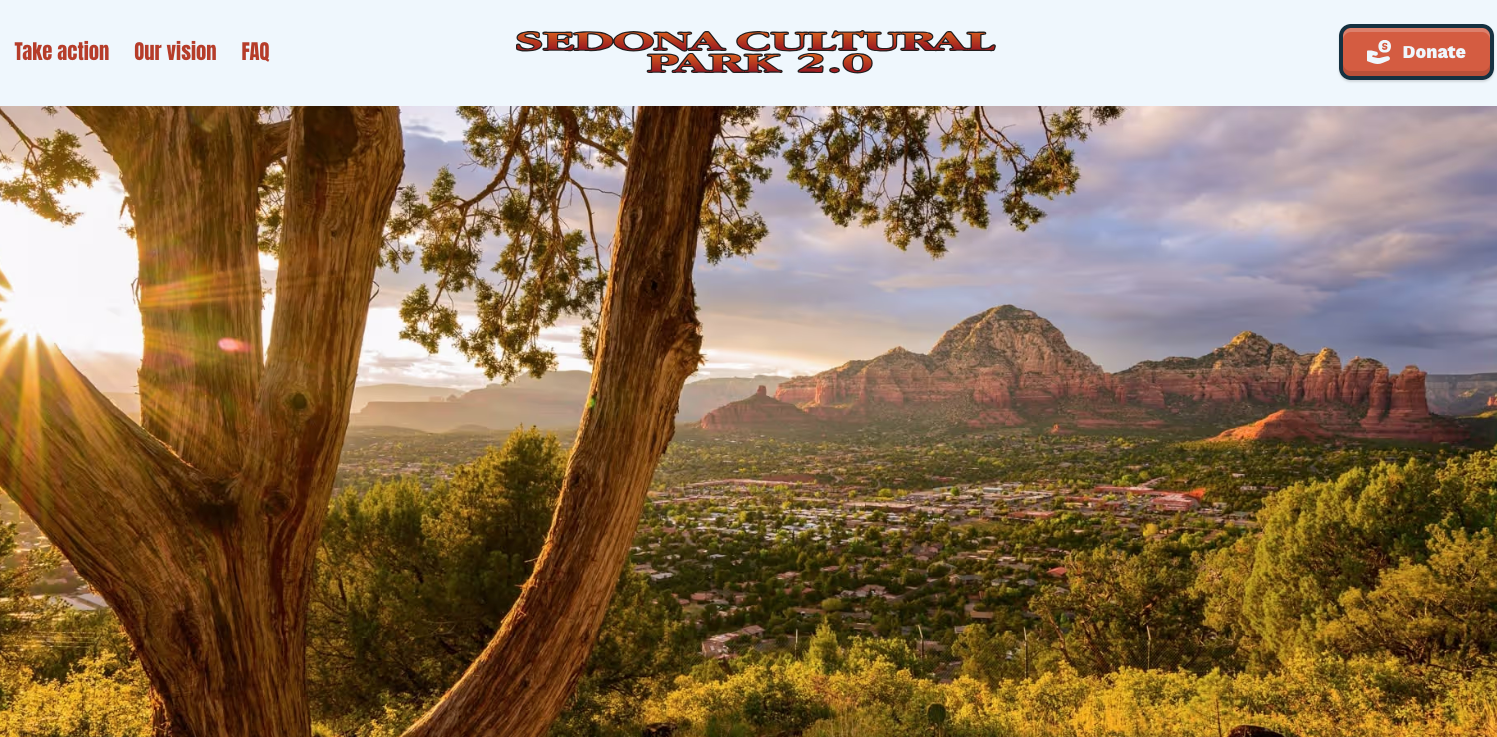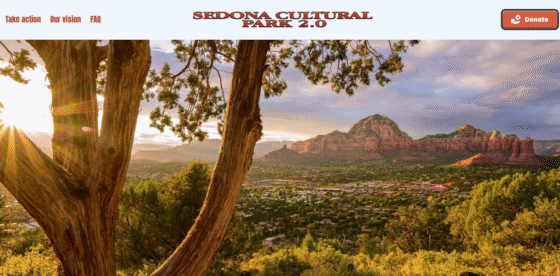By Steve Segner
Sedona AZ — There’s talk again of resurrecting a large theater or amphitheater at Sedona’s Western Gateway, which used to be called the Sedona Cultural Park — a 5,000-seat outdoor venue designed to “bring culture and events” back to the red rocks. It sounds romantic. The problem is, it’s a dream that doesn’t survive daylight, weather, or basic math.
Sedona is not Los Angeles, or even Prescott. We sit 100 miles from the nearest population center, separated by miles of desert and canyon. Any touring act — from a headliner like Jackson Browne to a mid-tier “B” act — has to make a deliberate detour off the main routing corridor. Most national tours run Phoenix–Tucson–San Diego or Phoenix–Las Vegas. Sedona is simply off the map.
To convince an artist to stop here, promoters must offer higher guarantees — $100,000 to $300,000 for a legacy artist. Now do the math. A 5,000-seat theater with a $75 average ticket yields about $262,000 gross at 70% occupancy — barely enough to cover the artist’s fee. The rest — production, insurance, staffing, and city support — comes from somewhere. Usually, that “somewhere” is the taxpayers.
This doesn’t reflect the high cost of marketing to create the audience in the first place. Are they coming from Phoenix, Prescott, Flagstaff, or the Verde Valley? Are we trying to convince people to “visit Sedona” as a tourist from Los Angeles, San Diego, Chicago, or Houston to attend a concert while they are vacationing? What does that kind of marketing cost? And let’s be honest, how many locals will be willing to pay $75 to listen to a “B” act?
Somewhere in this breakdown of the cost of operating the venue will be the reality of who pays for an operation that is operating in the red. The city? Cultural Park 2.0? Some commercial operator? The pope?
And remember, when the Cultural Park was operating in the early 2000s, the Sedona Performing Arts Center did not exist, with seating for almost 800 people. It’s available anytime during the year, no matter the weather. And if the event isn’t going to attract enough people to fill a large venue, why aren’t we just using SPACs more often and efficiently?
The Weather Window Problem
Sedona’s climate makes outdoor concerts a logistical gamble. From July through October, we face daily monsoon thunderstorms and lightning risks. From December through February, it’s too cold for comfortable outdoor events. That leaves only a few shoulder weeks in March–April and late October–November — barely enough time to host a short series of shows. Ironically, those same months coincide with Sedona’s peak tourism season, when hotels are already full and rooms top $400 or more a night.
Traffic, Noise, and Neighborhood Impact
Anyone who’s tried to leave Sedona on a Sunday afternoon knows our roads are already strained. Now imagine adding 2,000 concertgoers funneling through the Western Gateway — a two-lane road system with no shoulders and no mass transit capable of handling that load.
Wouldn’t the City have to provide police and traffic control for every show? That’s real money and overtime. When the Cultural Park was operating in the early 2000s, traffic management, parking, and security were all imported from the valley. And that contributed to the operational loss that eventually put them out of business.
So the traffic to Sedona for this venue will be mostly people from outside Sedona. Aren’t those called tourists? What happened to all the residents yelling and screaming at the city not to promote Sedona to increase tourism? Are the residents demanding that the city rebuild this facility, talking out of both sides of their mouths?
Noise is another unavoidable issue. Sound travels far in the canyon air at night. Even with modern sound design, the amplification required for outdoor performances will carry into surrounding neighborhoods. Residents moved to West Sedona for peace, not for the low thump of bass lines echoing off the red rocks at 10 p.m.
And don’t forget that when the Cultural Park was operating, it was subject to a series of sound-level restrictions established as a condition of its operation. And it was people who live nearby who drove most of this opposition. Sedona could be the Nimby capital of America. Don’t expect the nearby residents to make similar demands now.
A Lesson from History
Across America, large outdoor venues in small markets struggle or close. Their fatal flaw is not vision — it’s economics. Successful amphitheaters thrive when they are within 30–45 minutes of a major population center, have reliable summer weather, and can host dozens of events per year to spread fixed costs. Sedona fits none of these criteria.
We have a small resident base, a limited hotel workforce, volatile weather, and strong community restrictions on light and sound. We’ve been down this road before. The Cultural Park was built with similar hopes — and it failed. The same structural issues remain: location, cost, climate, and scale.
A Better Use for the Western Gateway
If the community truly wants cultural programming, we can achieve it without building a white elephant. A smaller, covered pavilion — 600 to 1,000 seats — could host chamber music, film, dance, and community gatherings for a few perfect-weather evenings each year. Such a space could share parking and shuttles, minimize sound, and stay financially sustainable. Sedona doesn’t need a commercial concert venue competing with Phoenix; it requires a community stage that enhances our cultural life without burdening our infrastructure.
What is the city proposing to do with the Western Gateway property. What is the proposal that came from the extensive year-long public outreach and debate with residents about the future of the Western Gateway? Go to this link and read the current city’s suggested master plan which includes a more modest outdoor amphitheater, type venue: https://plansedona.com/master-plan-july-2025-draft?document=1
The Bottom Line
A large Western Gateway theater is not a cultural investment — it’s a fiscal liability. Between the cost of talent, limited weather windows, traffic control, sound complaints, and distance from any large audience base, it’s a project that promises glamour but delivers debt. Sedona’s future depends on realism, not nostalgia. The Western Gateway should welcome visitors with open land, trail access, and perhaps a modest performing space that reflects Sedona’s spirit — not another failed monument to wishful thinking.
Lightning Safety and Outdoor Event Rules
Outdoor event operators nationwide follow strict lightning and storm safety standards set by the National Weather Service, the PGA, and the Event Safety Alliance. The key rule is the “30–30 Rule”: if lightning and thunder occur within 30 seconds, all activity stops and cannot resume until 30 minutes after the last thunder. Golf play halts when lightning is within 10 miles; concerts and outdoor theaters must suspend shows and evacuate crowds within an 8–10-mile strike zone. Power is shut down, stages cleared, and guests moved to enclosed shelters or vehicles. Venues must have weather detection, evacuation routes, and emergency coordination. In Sedona, that means on-site shelters, alerts, and traffic control for every summer event — a significant operational and liability challenge. These non-negotiable standards highlight why large outdoor venues in lightning-prone areas, such as Sedona’s monsoon corridor, face serious safety, insurance, and economic risks.
What’s really going on in this fanciful boondoggle discussion?
Now, let’s get down to the fundamental issue: in 2022, the Sedona City Council instructed the city manager to investigate the possibility of the city acquiring the 40 acres. Why? Because the city council had come to accept that the Nimby environment in Sedona would basically block almost all proposals for rental housing, especially those designed with greater density to reduce costs. And this reflected the fact that the vast majority of non-commercial use land in Sedona is single-family homes, and that’s where the opposite will originate.
And so they went down the path to acquire this piece of land for $22 million. And the primary motive was housing —not million-dollar houses, but townhomes and apartments that everyday middle-class citizens can afford to rent and, in some cases, buy. And if you listened to this conversation in 2022 at a public meeting, you would see that the City Council also acknowledged it as an opportunity to add more cultural value to Sedona through other improvements, such as park facilities. They even thought maybe a recreation Center like the city of Cottonwood has.
The 5000-seat or even a 2000-seat outdoor venue is truly a boondoggle and a fantasy by all of those pining for its resurrection. No business plan would stand up to scrutiny. The city isn’t gonna get into the entertainment business beyond what their Parks Department can do for the good of residents. Sedona may be mystical and magical, and that’s its attraction as a visitor and tourist destination for so many, but you can’t use magic to make this dream real. It’s a dream – that’s all.
And remember, I own a hotel, I like tourists. I want Sedona to be successful as a Tourism destination; it’s the lifeblood of this community. But even I can see it is just a dream – that’s all!







12 Comments
The Western Gateway: Time to Refocus on Housing, Not Distraction
Let’s confront the issue head-on.
The citizens of Sedona invested $22 million—in both cash and bond funds—to purchase approximately 40 acres of land with a clear and urgent purpose: to develop workforce housing. Yet, a vocal group of pro-event, anti-housing advocates is attempting to divert this investment by pushing housing to the outskirts and misleading the public with claims that Sedona needs “more open space.”
Let’s be honest—Sedona is already surrounded by millions of acres of protected red rock open space. What it lacks is attainable housing for the people who keep our community functioning—teachers, service workers, first responders, and others who make Sedona livable.
The proposal to rebuild the event center, add peripheral parking, and rebrand the area as a city park is not a plan—it’s a distraction. It lacks a viable business model, funding sources, and clear community benefit. Meanwhile, it undermines the city’s commitment to address one of Sedona’s most pressing problems: housing.
By pushing homes to the edges of the property, the project sacrifices any sense of community connectivity, replacing it with an ungrounded vision that benefits a few special interests at the expense of Sedona’s working families.
The Western Gateway—once envisioned as a solution—has devolved into a political and planning quagmire. The more we tinker with it, the more entangled and expensive it becomes.
It’s time for city leadership to refocus on the original mission: to build workforce housing, not another underfunded event venue. Sedona doesn’t need more empty “open space” rhetoric—it needs homes for the people who make this town thrive
Why revive the Cultural Park and the music Amphitheater???
A publicly owned amphitheater becomes a year-round economic engine that strengthens Sedona’s tourism base even during slower seasons, helping keep our hotels, restaurants, shops, and tour operators healthy. Because the venue would be owned by the City, the revenue it generates can be directed into community priorities—including true workforce housing—without raising taxes on residents. This model is already used successfully in places such as St. Augustine, Bend, Park City, Boulder, and Grand Rapids, where the amphitheater remains a public asset, but day-to-day concert operations are managed by a professional operator with national touring relationships. Cities choose this structure because it minimizes operational risk, preserves local control, and ensures programming aligns with the community’s character rather than outside commercial interests.
In Sedona, where many hotels are forced to send workers home during seasonal dips, this becomes especially meaningful: the amphitheater provides stable shoulder-season demand, helping businesses sustain staff and reducing the volatility that contributes to local workforce displacement. With the City retaining ownership, we protect the land, the quiet-town identity, and environmental standards—while leveraging an experienced operator to handle talent booking, production, security, and marketing at no added cost to taxpayers.
In other words: Sedona keeps the values, the City keeps the control, the community keeps the benefit—and the professionals handle the concerts. That’s precisely why this model is being adopted across the country, and why it makes sense here.
Why a City Should Own the Amphitheater
The city holds the land and the venue as a public asset.
This ensures:
• It stays dedicated to public benefit, not private real estate development.
• It can be used for community events, not just for-profit concerts.
• The city maintains control over noise, hours, cultural programming, and use rules.
But operating a modern amphitheater year-round—booking talent, running concessions, managing security, negotiating tour routing—requires specialized expertise.
So the city contracts a professional operator (Live Nation, AEG, OVG, ASM Global, Ryman Hospitality, or a nonprofit cultural foundation) to run it.
Benefits to the City
Revenue Without Operational Risk:
The operator pays rent / revenue share / ticket surcharge.
Lower Public Payroll & Liability:
City doesn’t have to staff or manage a complex event operation.
Guaranteed Professional Talent Booking:
National operators already route artists + have tour relationships.
Cost Control & Predictable Budgets:
Operator absorbs most variable operating expenses.
Capital Upgrades at Lower Cost:
Many operators co-fund improvements or naming-rights deals.
Economic Development Engine:
Concert nights drive restaurant, hotel, & transportation revenue.
Civic Identity & Cultural Value:
Venue becomes a signature gathering place.
There are dozens of other examples, but here’s one case study and I can point you to many more:
Venue: The St. Augustine Amphitheatre (commonly The Amp)
Capacity: ~4,700 (intentionally intimate)
Ownership: St. Johns County (public)
Operator: SJC Cultural Events, Inc. (local nonprofit with Live Nation routing support)
Why This Matters for Sedona
• St. Augustine, like Sedona, is a heritage + tourism destination with a delicate cultural ecosystem.
• They did not want a corporate identity takeover of their arts and natural environment.
• So the city kept ownership and ensured:
• Community programming is preserved.
• Noise, hours, and crowd control are locally enforced.
• The nonprofit operator professionally handles shows while leveraging national tour networks.
The Outcome:
St Augustine Amphitheater
Became #1 ranked amphitheater of its size in the U.S.
National reputation without losing local soul
Increased tourism during shoulder seasons
Hotels, restaurants, taxis all benefit
Venue now funds free community cultural events
Public benefit anchored in live music economy
Sorry but Sedona already has several music venues that struggle to sell tickets so why start another one in the exact same image of the one sitting there rotting? I’m all for using that land for affordable housing for our local unhoused employees but am against spending a red cent upon another failed music venue because it would end up sitting and rotting again once the nuances of it wears off again. If big name music artists are willing to come (most wouldn’t waste their time or money) here it is easy enough to build a temporary stage in any open field in town. Think Woodstock which had no permanent expensive facilities and was held in a farmers field.
“Sedona already has several music venues that struggle to sell tickets”?
Since when? I dare to name two such venues. Heck, just name one.
I don’t think you live in Sedona. What a ridiculous comment.
Jenn May, I like your thoughts!!
I join you in Jill’s sentiments. Jennifer May makes many compelling points, but doesn’t address some very major counterpoints that we need to know more about to further the conversation:
1) Parking! I’ve heard shuttle from a lot at The Dells. That could work but has to be baked into any official proposal. How many spots can fit if we also have parking there.
2) The need for housing there. Having traffic from both uses will make for a very tough situation for those that live there and on the loop road, and the area in general, leading to the operator having to constantly hire off-duty police (who don’t live here so will need to be enticed) for traffic control.
3) Intersection realignment. Two left turn lanes on 89a northbound into the property. Two lanes out of the property to 89a northbound. Land use for queuing of vehicles leaving the property.
4) Money held in escrow payable to the city if the venue shuts down. We shouldn’t have to shoulder deconstruction if the venue goes sideways…again.
5) Detailed analysis of why the non-exclusivity issue is not an an issue anymore (performers at appropriate scale can do Flagstaff and Phoenix and people there won’t feel the need to drive this way, figuring out lodging at the high Average Room Rate we have here. See #4 above about the city not taking risk
6) Sound issues. I’m not too concerned about this one as only lodging is very close. Nearest houses are 1/4 mile or more away. But those houses will hear something. Others assure us the sound engineering is now way better equipped to control that. But more should be said about this.
7) What other uses are precluded while a show is going on? If Parks & Rec gets the 1 acre they have requested for events (food truck festivals), or other open space is available for rent, who is going to want to have an event there while a concert is going on? Traffic and parking would be madness.
8) Is the operator going to ensure parking control at the trailhead or other places? Tourists are notorious for flaunting the rules. The city should not have to shoulder the cost of parking enforcement (including towing which is not really a thing here, and booting isn’t good enough when you’re trying to park to hike/bike the trails there.
All up, to me, it just has too many impediments
Re-opening the park as a music venue would require a tremendous law enforcement and security apparatus that Sedona does not have. You’d need patrols for the city, patrols for traffic control of the event, officers and security on the outside perimeter as well as inside and the ingress point in light of the propensity for mass shooters and other evil doers that target soft target events like concerts. I doubt anyone has even considered that aspect of the issue.
First – The citizens did not buy the Cultural Park. The council did, with taxpayer money…and debt. Three of those council members were in the process of being replaced, they either lost the election or elected not to run. So, the outgoing council had little regard for the will of the people. It was a lame duck council with a lame duck purpose.
Second – We had previous owners who had multiple ideas that involved housing or various types. And were all shot down, water, traffic, noise, every excuse in the book. And now it is OK? Strange.
Third – The Forest Service conveyed the land initially for Culture – not housing. Sorry to bring up history, and the city spent a lot of grant money on the original Cultural Park.
Fourth – If you want affordable housing, we have had at least one or more architectural concept plans for the Dells – 8 minutes out of town, where it is actually FLAT and you’re not trying to build on hills and rock. DUH…of course, there’s a $31 million proposal for a “bus barn” and more city employees, someone’s wet dream for an already zero revenue losing money deal.
Fifth – put a stop to the nonsense. Sign the initiative petition that prevents housing and forces the city to use the land for what it was designed for – Culture.
Maybe then the city will take all the millions that they seem to have laying around and build another injection well that can free up over 200 acres (not 40) and create housing opportunities for people not only in Sedona but the rest of the Verde Valley – and that takes leadership at the council to interface with the other Verde Valley Communities.
Don’t hold your breath.
@ Michael Schroeder.
Injection well !!!!!!!
So that is where you pump so called treated water into the aquifer, where many people get their drinking water.
The so called treatment does not remove pharmaceuticals, so your kid gets to drink what ever drugs they gave to your dying grandma.
Sedona saw what overcapacity looks like just after the pandemic. Anyone who hiked popular trails during that time was horrified. Devil’s Bridge, for example, was single-file lines up and down, like pictures of overcrowding the summits in the Himalayas. Trash in the creek was absurd. 89a in the canyon was a parking lot.
Overcapacity gripped numerous national parks at the same time so the NPS put limits on visitation. Seems reasonable to anyone who doesn’t want the experience to suck and save those special places for the long term.
Sedona’s response? Learn nothing. Build more of the same. Pretend we aren’t near the peak.
Aren’t there like 4 or 5 more hotels in development right now? Each will require how many dozens of workers? And despite near/record tax receipts year after year, Sedona City Council and Staff want even more too. They want to double down on a certain type of corporate growth and soulless development, regardless of what it means for the people who live here or the people who visit or the landscape. With their palms in the air, you hear Councilors say things like “the train has left station” or “no one owns the views” or “the people are coming” as if we’re powerless victims of an inevitable tide. We aren’t and it is so f-ing embarrassing.
We don’t need to change our ordinances or building codes, we don’t need to sacrifice cultural parks or quality of life to accommodate their specific kind of limitless growth. Building restrictions aren’t simply a reflection of NIMBYism as Steve and Bear would have you believe. Two story building heights in Sedona are reasonable guardrails to help prevent over development and over capacity (and improves quality of life for residents too). I certainly don’t want their 3-7 story buildings. And we don’t need them.
(I know this will sound controversial, but incidentally, instead of hotels we should encourage small, locally owned STRs. Lighter footprint and a more sustainable model.)
What Bear and Steve—and many Councilors and Staff—always seem to refuse to discuss are limits. In Digg’s presentation for example, they claimed we were short approximately 1200 units. I asked if we build all 1200 would we be done. They said we’d never be done, that it would never be enough. I’d encourage everyone to think about what that means.
These are the people who will be remembered as those who wrecked Sedona. Maybe we should commission some artists to make plaques about it. Maybe post them along 89a in Uptown as part of a rotating “Destroyers” exhibit. Maybe a show at City Hall.
I don’t know about you, but I’m really looking forward to a vote on the Cultural Park.
So hotels are ruining Sedona not unregulated Air B&Bs?
Heck build all the hotels you want. Go belly up turn them into places for people to live!
Do we have a traffic problem or not? That is the real question to most everything in this town.
Well since it’s designated as a Cultural Park upon Cultural Land then perhaps it should become a blank canvas open field void of the corpse of the amphitheater and utilized to host cultural events such as Pau Wau’s, Native American, Asian American, Black American, Irish American etc. historical events and displays be they of the arts or lecturers/guest speakers whatever. Seems like a better use of a cultural location than opening it up to development of any sort.